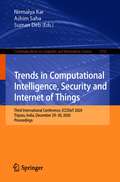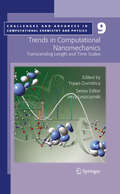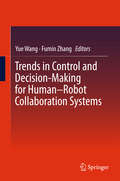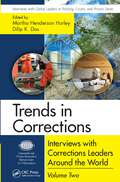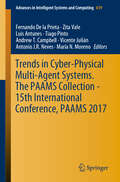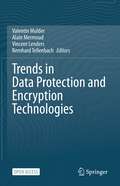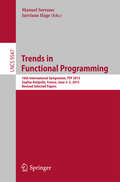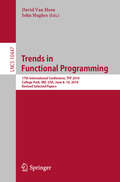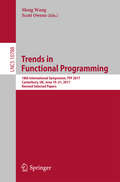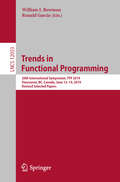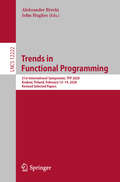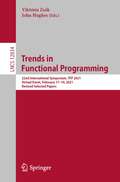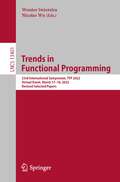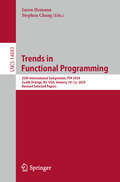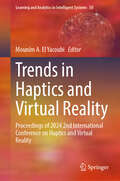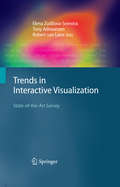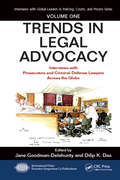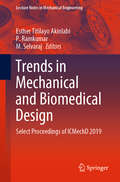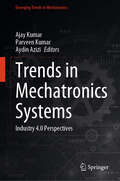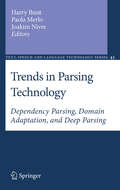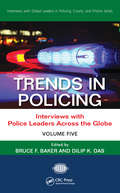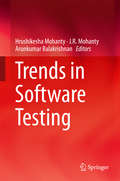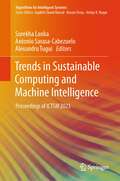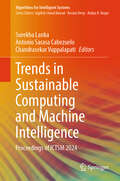- Table View
- List View
Trends in Computational Intelligence, Security and Internet of Things: Third International Conference, ICCISIoT 2020, Tripura, India, December 29-30, 2020, Proceedings (Communications in Computer and Information Science #1358)
by Ashim Saha Nirmalya Kar Suman DebThis volume constitutes the refereed proceedings of the Third International Conference on Computational Intelligence, Security and Internet of Things, ICCISIoT 2020, held in Agartala, India, in December 2020. Due to the COVID-19 pandemic the conference was held online. The 23 full papers and 4 short papers were carefully reviewed and selected from 113 submissions. The papers are organised according to the following topics: computational intelligence, security, and internet of things.
Trends in Computational Nanomechanics
by Traian DumitricaTrends in Computational Nanomechanics reviews recent advances in analytical and computational modeling frameworks to describe the mechanics of materials on scales ranging from the atomistic, through the microstructure or transitional, and up to the continuum. The book presents new approaches in the theory of nanosystems, recent developments in theoretical and computational methods for studying problems in which multiple length and/or time scales must be simultaneously resolved, as well as example applications in nanomechanics. This title will be a useful tool of reference for professionals, graduates and undergraduates interested in Computational Chemistry and Physics, Materials Science, Nanotechnology.
Trends in Constraint Programming
by Narendra Jussien Frédéric Benhamou Barry O'SullivanThis title brings together the best papers on a range of topics raised at the annual International Conference on Principles and Practice of Constraint Programming. This conference provides papers and workshops which produce new insights, concepts and results which can then be used by those involved in this area to develop their own work.
Trends in Control and Decision-Making for Human–Robot Collaboration Systems
by Yue Wang Fumin ZhangThis book provides an overview of recent research developments in the automation and control of robotic systems that collaborate with humans. A measure of human collaboration being necessary for the optimal operation of any robotic system, the contributors exploit a broad selection of such systems to demonstrate the importance of the subject, particularly where the environment is prone to uncertainty or complexity. They show how such human strengths as high-level decision-making, flexibility, and dexterity can be combined with robotic precision, and ability to perform task repetitively or in a dangerous environment. The book focuses on quantitative methods and control design for guaranteed robot performance and balanced human experience from both physical human-robot interaction and social human-robot interaction. Its contributions develop and expand upon material presented at various international conferences. They are organized into three parts covering: one-human-one-robot collaboration; one-human-multiple-robot collaboration; and human-swarm collaboration. Individual topic areas include resource optimization (human and robotic), safety in collaboration, human trust in robot and decision-making when collaborating with robots, abstraction of swarm systems to make them suitable for human control, modeling and control of internal force interactions for collaborative manipulation, and the sharing of control between human and automated systems, etc. Control and decision-making algorithms feature prominently in the text, importantly within the context of human factors and the constraints they impose. Applications such as assistive technology, driverless vehicles, cooperative mobile robots, manufacturing robots and swarm robots are considered. Illustrative figures and tables are provided throughout the book. Researchers and students working in controls, and the interaction of humans and robots will learn new methods for human-robot collaboration from this book and will find the cutting edge of the subject described in depth.
Trends in Corrections: Interviews with Corrections Leaders Around the World, Volume Two (Interviews with Global Leaders in Policing, Courts, and Prisons)
by Dilip K. Das Martha Henderson HurleyThe first volume of the Trends in Corrections: Interviews with Corrections Leaders Around the World series introduced readers to the great diversity that exists cross-culturally in the political, social, and economic context of the correctional system. Presenting transcribed interviews of corrections leaders, it offered a comprehensive survey of co
Trends in Cyber-Physical Multi-Agent Systems. The PAAMS Collection - 15th International Conference, PAAMS 2017 (Advances in Intelligent Systems and Computing #619)
by Vicente Julián Fernando De la Prieta Zita Vale Tiago Pinto Luis Antunes Andrew T. Campbell María N. Moreno Antonio J. R. NevesPAAMS, the International Conference on Practical Applications of Agents and Multi-Agent Systems is an evolution of the International Workshop on Practical Applications of Agents and Multi-Agent Systems. PAAMS is an international yearly tribune to present, to discuss, and to disseminate the latest developments and the most important outcomes related to real-world applications. It provides a unique opportunity to bring multi-disciplinary experts, academics and practitioners together to exchange their experience in the development of Agents and Multi-Agent Systems. This volume presents the papers that have been accepted for the 2017 in the special sessions: Agent-Based Social Simulation, Modelling and Big-Data Analytics (ABM); Advances on Demand Response and Renewable Energy Sources in Agent Based Smart Grids (ADRESS); Agents and Mobile Devices (AM); Computer vision in Multi-Agent Robotics (RV); Persuasive Technologies (PT); Web and Social Media Mining (WASMM). The volume also includes the papers accepted for publication in the Doctoral Consortium (DCAI, DCAI-DECON, ISAMI, MIS4TEL, PAAMS, PACBB 2017 conferences).
Trends in Data Protection and Encryption Technologies
by Alain Mermoud Valentin Mulder Vincent Lenders Bernhard TellenbachThis open access book reports the results of a study conducted in Switzerland in 2022 to provide an overview of the changing landscape of encryption and data protection technologies and their global usage trends. The Swiss Confederation tasked the Cyber-Defence Campus (CYD Campus) to identify the 38 most relevant encryption and data protection technologies, analyze their expected evolution until 2025, and derive implications for the military, civil society, and economy sectors.Fifty experts from academia, government, and industry have contributed to this study and provided their viewpoints on the different technologies and trends. This comprehensive collection of factsheets provides a reference for organizations and individuals that need to elaborate coherent and efficient data protection and encryption strategies in the coming years. The 38 technologies have been sorted into five categories. First, encryption foundations represent the technologies used to create other encryption applications. Second, low-level applications represent the technologies that focus on micro functionalities. Third, high-level applications represent the technologies that focus on more abstract and macro functionalities. Fourth, data protection represents the technologies used to protect data without encrypting these data. Finally, use cases represent concrete ways the different technologies can be used together to create a working solution.The book serves as a guide for decision-making within administrations, government organizations, and industry. It will also be interesting for the tech-savvy board member or engineers looking to get an entry point into data protection topics. Last not least, the book will also be a valuable reading for anyone interested in data protection and encryption.
Trends in Functional Programming
by Manuel Serrano Jurriaan HageThis book constitutes the thoroughly refereed revised selected papers of the 16th International Symposium on Trends in Functional Programming, TFP 2015, held in Sophia Antipolis, France, in June 2015. The 8 revised full papers included in this volume were carefully and selected from 26 submissions. TFP is an international forum for researchers with interests in all aspects of functional programming, taking a broad view of current and future trends in the area. It aspires to be a lively environment for presenting the latest research results, and other contributions, described in draft papers submitted prior to the symposium.
Trends in Functional Programming: 17th International Conference, TFP 2016, College Park, MD, USA, June 8-10, 2016, Revised Selected Papers (Lecture Notes in Computer Science #10447)
by John Hughes David Van HornThis book constitutes the refereed proceedings of the 17th International Conference on Trends in Functional Programming, TFP 2016, held in College Park, USA, in June 2016.The 10 full papers presented in this volume were carefully reviewed and selected from 18 submissions. The papers were organized in topical sections named: implementation techniques; types and verification; and programming.
Trends in Functional Programming: 18th International Symposium, Tfp 2017, Canterbury, Uk, June 19-21, 2017, Revised Selected Papers (Lecture Notes In Computer Science #10788)
by Meng Wang Scott OwensThis book constitutes the thoroughly refereed revised selected papers of the 18th International Symposium on Trends in Functional Programming, TFP 2017, held in Canterbury, UK, in June 2017. The 8 revised full papers were selected from 16 submissions and present papers in all aspects of functional programming, taking a broad view of current and future trends in the area.
Trends in Functional Programming: 20th International Symposium, TFP 2019, Vancouver, BC, Canada, June 12–14, 2019, Revised Selected Papers (Lecture Notes in Computer Science #12053)
by William J. Bowman Ronald GarciaThis book constitutes the thoroughly refereed revised selected papers of the 20th International Symposium on Trends in Functional Programming, TFP 2019, held in Vancouver, Canada, in June 2019. The 6 revised full papers were selected from 11 submissions and present papers in all aspects of functional programming, taking a broad view of current and future trends in the area. It aspires to be a lively environment for presenting the latest research results, and other contributions, described in draft papers submitted prior to the symposium.
Trends in Functional Programming: 21st International Symposium, TFP 2020, Krakow, Poland, February 13–14, 2020, Revised Selected Papers (Lecture Notes in Computer Science #12222)
by John Hughes Aleksander ByrskiThis book constitutes revised selected papers from the 21st International Symposium on Trends in Functional Programming, TFP 2020, which was held in Krakow, Poland, during February 13-14, 2020. The 11 full papers presented in this volume were carefully reviewed and selected from 22 submissions. They were organized in topical sections named: domain-specific languages; debugging and testing; reasoning and effects; and parallelism.
Trends in Functional Programming: 22nd International Symposium, TFP 2021, Virtual Event, February 17–19, 2021, Revised Selected Papers (Lecture Notes in Computer Science #12834)
by John Hughes Viktória ZsókThis book constitutes revised selected papers from the 22nd International Symposium on Trends in Functional Programming, TFP 2021, which was held virtually in February 2020. The 6 full papers presented in this volume were carefully reviewed and selected from 18 submissions. They were organized in topical sections about nested parallelism, semantics, task-oriented programming and modelling, translating, proving functional programs. Chapter ‘Dataset Sensitive Autotuning of Multi-Versioned Code based on Monotonic Properties’ is available open access under a Creative Commons Attribution 4.0 International License via link.springer.com. Chapter ‘High-level Modelling for Typed Functional Programming’ is available open access under a Creative Commons Attribution 4.0 International License via link.springer.com.
Trends in Functional Programming: 23rd International Symposium, TFP 2022, Virtual Event, March 17–18, 2022, Revised Selected Papers (Lecture Notes in Computer Science #13401)
by Wouter Swierstra Nicolas WuThis book constitutes revised selected papers from the 23rd International Symposium on Trends in Functional Programming, TFP 2022, which was held virtually in March 2022.The 9 full papers presented in this volume were carefully reviewed and selected from 17 submissions. They deal with all aspects of functional programming, taking a broad view of current and future trends in the area.
Trends in Functional Programming: 25th International Symposium, TFP 2024, South Orange, NJ, USA, January 10–12, 2024, Revised Selected Papers (Lecture Notes in Computer Science #14843)
by Jason Hemann Stephen ChangThis book constitutes the refereed proceedings of the 25th International Symposium on Trends in Functional Programming, TFP 2024, held in South Orange, NJ, USA, during January 10–12, 2024. The 10 full papers included in this book were carefully reviewed and selected from 14 submissions. Topical sections as follows: dependent type systems; compiler optimizations; and DSL design and implementation.
Trends in Haptics and Virtual Reality: Proceedings of 2024 2nd International Conference on Haptics and Virtual Reality (Learning and Analytics in Intelligent Systems #50)
by Mounîm A. El YacoubiThis book encompasses the collective wisdom and groundbreaking insights shared on 2024 2nd International Conference on Haptics and Virtual Reality (ICHVR 2024). It delves into the intricate field of Haptics and Virtual Reality, providing novel insights and profound discussions on its fundamental principles and application. It is tailored for researchers, engineers, and practitioners deeply involved in the field of Haptics and Virtual Reality. Comparing to last edition, this book mainly presents real-world examples of how Haptics and Virtual Reality technology is being used today.
Trends in Interactive Visualization
by Elena Zudilova-Seinstra Tony Adriaansen Robert Van LiereThe purpose of Interactive Visualization is to develop new scientific methods to increase scientists' abilities to explore data and to understand better the results of experiments based on extensive calculations. These techniques not only provide users with a possibility to view the data but also permit them to use interaction capabilities to interrogate and navigate through datasets and communicate these insights. This book is a unique multi-disciplinary collection of scientific articles, which provides readers with insight in Interactive Visualization from various perspectives, representing the state-of-the-art with the special emphasis on: Advanced visualization algorithms and methods, Interactive data exploration, Display systems and interaction techniques, Multi-modal and collaborative visualization, Design and evaluation of interactive visualization tools and systems, Various application topics.
Trends in Legal Advocacy: Interviews with Prosecutors and Criminal Defense Lawyers Across the Globe, Volume One (Interviews with Global Leaders in Policing, Courts, and Prisons)
by Jane Goodman-Delahunty and Dilip K. DasA new installment of the series of Interviews with Global Leaders in Policing, Courts, and Prisons, this book expands upon the criminal justice coverage of earlier volumes, offering the voices of 14 lawyers from 13 diverse locales, including countries in Africa, North America, South America, Europe, and the Asia-Pacific region. This book is intended for students and others focusing on law and legal studies, policing, psychology and law, criminology, justice studies, public policy, and for all those interested in the front lines of legal change around the world. Featuring versatile chapters perfect for individual use or as part of a collection, this volume offers a personal approach to the legal world for students and experienced professionals.
Trends in Mechanical and Biomedical Design: Select Proceedings of ICMechD 2019 (Lecture Notes in Mechanical Engineering)
by Esther Titilayo Akinlabi P. Ramkumar M. SelvarajThis book comprises select papers presented at the International Conference on Mechanical Engineering Design (ICMechD) 2019. The volume focuses on the recent trends in design research and their applications across the mechanical and biomedical domain. The book covers topics like tribology design, mechanism and machine design, wear and surface engineering, vibration and noise engineering, biomechanics and biomedical engineering, industrial thermodynamics, and thermal engineering. Case studies citing practical challenges and their solutions using appropriate techniques and modern engineering tools are also discussed. Given its contents, this book will prove useful to students, researchers as well as practitioners.
Trends in Mechatronics Systems: Industry 4.0 Perspectives (Emerging Trends in Mechatronics)
by Ajay Kumar Aydin Azizi Parveen KumarThis book consists of twelve chapters covering the design aspects, their feasibility, mathematical modeling by numerical, experimental, computational and simulation approaches. It discusses how different internet technologies integrate mechatronics systems with people, products and complex systems. The methodology and tools included in this book focus on contemporary aspects of integrating Industry 4.0 and mechatronics systems for new means and models to achieve a sustainable green environment. Readers will get an insight into the current development of mechatronics systems in the context of scientific disciplines and present new results of research and development, indicating the trends of development in this interdisciplinary field.
Trends in Parsing Technology
by Harry Bunt Joakim Nivre Paola MerloComputer parsing technology, which breaks down complex linguistic structures into their constituent parts, is a key research area in the automatic processing of human language. This volume is a collection of contributions from leading researchers in the field of natural language processing technology, each of whom detail their recent work which includes new techniques as well as results. The book presents an overview of the state of the art in current research into parsing technologies, focusing on three important themes: dependency parsing, domain adaptation, and deep parsing. The technology, which has a variety of practical uses, is especially concerned with the methods, tools and software that can be used to parse automatically. Applications include extracting information from free text or speech, question answering, speech recognition and comprehension, recommender systems, machine translation, and automatic summarization. New developments in the area of parsing technology are thus widely applicable, and researchers and professionals from a number of fields will find the material here required reading. As well as the other four volumes on parsing technology in this series this book has a breadth of coverage that makes it suitable both as an overview of the field for graduate students, and as a reference for established researchers in computational linguistics, artificial intelligence, computer science, language engineering, information science, and cognitive science. It will also be of interest to designers, developers, and advanced users of natural language processing systems, including applications such as spoken dialogue, text mining, multimodal human-computer interaction, and semantic web technology.
Trends in Policing: Interviews with Police Leaders Across the Globe, Volume Five (Interviews with Global Leaders in Policing, Courts, and Prisons #1)
by Dilip K. Das Bruce F. BakerTrends in Policing: Interviews with Police Leaders Across the Globe, Volume Five, is based on the premise that police officials have a wealth of experience that can make significant contributions to our understanding of the prospects and problems of policing today. Each chapter consists of an interview with a policing leader that explores their understanding of policing developments and current challenges in their countries and internationally, and examines how they evaluate or interpret these developments.
Trends in Software Testing
by Hrushikesha Mohanty J. R. Mohanty Arunkumar BalakrishnanThis book is focused on the advancements in the field of software testing and the innovative practices that the industry is adopting. Considering the widely varied nature of software testing, the book addresses contemporary aspects that are important for both academia and industry. There are dedicated chapters on seamless high-efficiency frameworks, automation on regression testing, software by search, and system evolution management. There are a host of mathematical models that are promising for software quality improvement by model-based testing. There are three chapters addressing this concern. Students and researchers in particular will find these chapters useful for their mathematical strength and rigor. Other topics covered include uncertainty in testing, software security testing, testing as a service, test technical debt (or test debt), disruption caused by digital advancement (social media, cloud computing, mobile application and data analytics), and challenges and benefits of outsourcing. The book will be of interest to students, researchers as well as professionals in the software industry.
Trends in Sustainable Computing and Machine Intelligence: Proceedings of ICTSM 2023 (Algorithms for Intelligent Systems)
by Surekha Lanka Antonio Sarasa-Cabezuelo Alexandru TuguiThe book is a collection of best selected research papers presented at International Conference on Trends in Sustainable Computing and Machine Intelligence (ICTSM 2023) organized by Stamford International University, Bangkok, Thailand, during October 5–6, 2023. The book includes original research by researchers working in the field of machine learning. The book covers important topics like decision support systems, neural networks and applications, machine learning, natural language processing, automated problem solving, AI and evolutionary algorithms, intelligent information systems, computational intelligence, computer vision and image processing, cognitive and biologically inspired vision, soft computing and applications, hybrid intelligent systems, distributed computing, pattern recognition and analysis, ubiquitous and high-performance computing, security, trust and privacy, big data for sustainable computing, and energy-aware machine learning.
Trends in Sustainable Computing and Machine Intelligence: Proceedings of ICTSM 2024 (Algorithms for Intelligent Systems)
by Chandrasekar Vuppalapati Surekha Lanka Antonio Sarasa CabezueloThis book is a collection of best selected research papers presented at International Conference on Trends in Sustainable Computing and Machine Intelligence (ICTSM 2024) organized by Stamford International University, Bangkok, Thailand, during September 12–13, 2024. The book includes original research by researchers working in the field of machine learning. The book covers important topics like decision support systems, neural networks and applications, machine learning, natural language processing, automated problem solving, AI and evolutionary algorithms, intelligent information systems, computational intelligence, computer vision and image processing, cognitive and biologically inspired vision, soft computing and applications, hybrid intelligent systems, distributed computing, pattern recognition and analysis, ubiquitous and high-performance computing, security, trust and privacy, big data for sustainable computing, and energy-aware machine learning.
